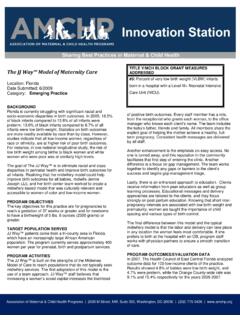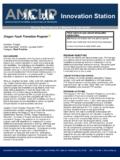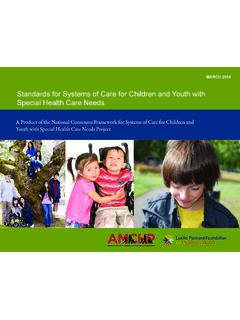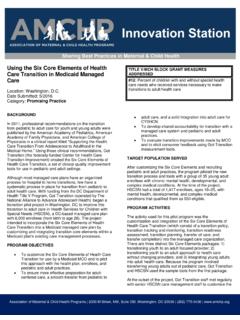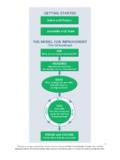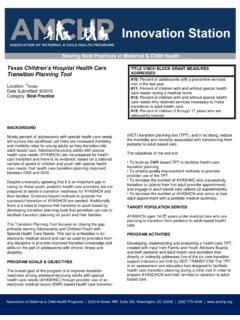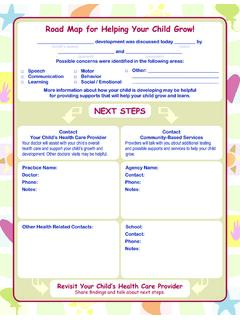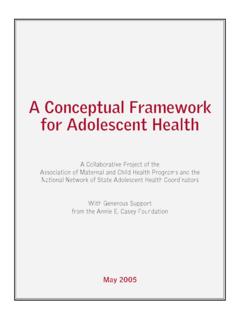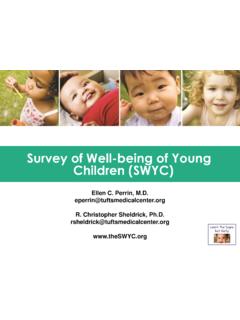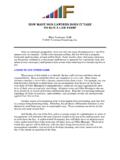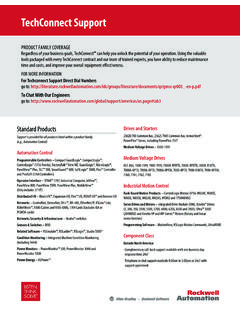Transcription of Understanding Title V of the Social Security Act - …
1 Understanding Title V of the Social Security Act Title V-fundedTitle V-fundedTitle V-fundedTitle V-fundedtraining,training,training,train ing, demonstration, and demonstration, and demonstration, and demonstration, andresearch programsresearch programsresearch programsresearch programsaddress the Social ,address the Social ,address the Social ,address the Social ,financial, behavioral,financial, behavioral,financial, behavioral,financial, behavioral,and structuraland structuraland structuraland structuralbarriers to healthbarriers to healthbarriers to healthbarriers to healthcare faced by manycare faced by manycare faced by manycare faced by manywomen, children,women, children,women, children,women, children,and families. and families. and families. and families. addressed by theseaddressed by theseaddressed by theseaddressed by theseinitiatives include:initiatives include:initiatives include:initiatives include:AreasAreasAreasAreaspediatric and adolescent AIDS injury and violence prevention health and safety in child care school-based and school-linked health services families as partners immunization sudden infant death syndrome genetics Title V-funded training, perinatal systems demonstration, and women s health research programs address the Social , adolescent health financial, behavioral, and structural substance abuse barriers to health nutrition care faced by many women, children, oral health and families.
2 Areas addressed by theseinformation resources and services initiatives include: early discharge policies for childbirth public health training technical assistance and consultation children with special health needs data analysis and applied technology abstinence education public/private partnerships for health promotion and prevention infant mortality reduction hemophilia lead poisoning national preventive health standards and guidelines access to healthcare i Understanding Title V ofUnderstanding Title V ofUnderstanding Title V ofUnderstanding Title V ofUnderstanding Title V of the Social Security Actthe Social Security Actthe Social Security Actthe Social Security Actthe Social Security Act A Guide to the Provisions of the Federal Maternal and Child Health Block Grant ContentsContentsContentsContentsContents Page Section Number of Law FOREWORD iii OVERVIEW iv INTRODUCTION Authorization of Appropriations 1 501 Funding and Allocation Provisions 3 502
3 Criminal Penalties for False Statements 3 507 Discrimination Prohibitions 4 508 Administration of Title V 4 509 FORMULA GRANTS TO STATES Purposes of MCH Formula Grants to States 5 501 Assignment of Federal Personnel in Lieu of Block Grant Funds 6 503 Obligations, Expenditures and Matching Requirements 6 503 Prohibitions 6 504 Application for the State Allocation 7 505 Regulations, Reports, and Audits 9 506 DISCRETIONARY GRANTS SPRANS Project Categories and Funding Levels 9 501 & 502 Description of SPRANS Project Categories 11 501 Description of CISS Project Categories 12 501 Eligibility 13 502 How to Apply for a SPRANS or CISS Grant 13 ABSTINENCE EDUCATION Separate Abstinence Education Grant Program 13 510 iii FOREWORDFOREWORDFOREWORDFOREWORDFOREWORD Since its inception, the Maternal and Child Health (MCH) Services Block Grant ( Title V of the Social Security Act) has provided a foundation for ensuring the health of our Nation s mothers and children.
4 With the passing of the Social Security Act in 1935, the Federal Government, through Title V, pledged its support of State efforts to extend health and welfare services for mothers and children. This landmark legislation resulted in the estab-lishment of State departments of health or public welfare in some States, and facilitated the efforts of existing agencies in others. Over the years, the achievements of Title V-supported projects have been inte-grated into the ongoing care system for children and families. Landmark projects have produced guidelines for child health supervision from infancy through adoles-cence; influenced the nature of nutrition care during pregnancy and lactation; recommended standards for prenatal care; identified successful strategies for the prevention of childhood injuries; and developed health safety standards for out-of-home child care facilities. This booklet provides an overview of Title V for those new to the Block Grant program and a compact guide for those familiar with the Title V programs.
5 For each portion of the law, a short synopsis is provided and relevant criteria explained. In addition, cites for the pertinent sections of Title V are included so that those interested in more detailed information can refer to the Title itself. Although Title V has been frequently amended over the years, the underlying goal has remained constant: continued improvement in the health, safety, and well-being of mothers and children. Peter C. van Dyck, , Associate Administrator for Maternal and Child Health Health Resources and Services Administration iv OVERVIEWOVERVIEWOVERVIEWOVERVIEWOVERVIEW Title V V V V V August 1935. In the face of the Great Depression, cutbacks in Federal health programs, and declining health for mothers and children, President Franklin Delano Roosevelt signs into law new legislation to promote and improve maternal and child health nation-wide. Title V of the Social Security Act is born.
6 Sixty-five years later, Title V remains the longest lasting public health legislation in our Nation s history. Created as part of a broad-sweeping Social rather than health legislation, the legacies of Title V programs are deep and widespread. 1935-40. Title V provides programs for maternity, infant, and child care, and a full range of medical services for children, including children with congenital disabilities. By 1938, every State but one has a Crippled Children s (CC) Program aimed at the Social and emotional, as well as the physical needs of these children. They represent the first medical care programs supported on a continual basis with Federal grants-in-aid money. 1940s. The Emergency Maternity Infant Care Program (EMIC), administered by the Maternal and Child Health Bureau and the State Title V agencies, establishes a service delivery system that provides free and complete maternity and infant health care for the wives and infants of the four lowest grades of servicemen.
7 At the time of its implementa-tion, EMIC represents the most extensive public medical care program in history. 1950s. New program initiatives are developed to respond to new information about infant mortality rates and risks and information that points to the movement of health care providers away from the cities and rural areas toward suburban areas. In addition, this decade sees the beginning of special funding for projects targeting mentally retarded children, later referred to as MR funds. 1960s-70s. The Maternal and Infant Care Programs (MIC) and Children and Youth Programs (C&Y) provide comprehensive child and reproductive health care services to millions of low-income women and children. The services developed by the programs for prenatal care, well-baby care, and family planning become models for the country. 1970s. The Improved Pregnancy Outcomes Program (IPO) promotes greater access to appropriate levels of care for pregnant women and infants in chosen geographic regions.
8 The 34 States that participate in this program including 13 that have very high rates of infant mortality experience greater rates of decline in infant mortality than does the rest of the country. 1980s. The Maternal and Child Health Services Block Grant is created in 1981, consoli-dating under Title V seven former categorical child health programs into a single program of formula grants to States supported by a Federal special projects authority. States adopt injury prevention as a public health issue. The Emergency Medical Services for Children (EMSC) program is created in recognition of the fact that children have special needs when they are critically ill or injured. The program provides training and education in pediatric emergency health care, and influences the development of pediatric emer-gency equipment and standards. v 1990s. The Maternal and Child Health Bureau and its partners remain dedicated to improving the health of all the Nation s women and children.
9 Significant amendments to Title V in 1989 and adoption of the Government Perfor-mance Results Act (GPRA) of 1993 usher in an era of greater sophistication in assessing unmet service needs and improved accountability in measur-ing program performance and strengthening an already close Federal-State partnership. State data on health status and services are collected electronically and made available nationally via the Title V Information System Web site ( ). Major new child health legislative initiatives Healthy Start in 1991 and the State Child Health Insurance Program (SCHIP) in 1997 target long-standing national concerns over infant mortality and uninsured children, drawing heavily on MCH professional expertise and organizational support. Abstinence Education is added to Title V as a categorical program separate from the Block Grant in 1996. 2000. The Maternal and Child Health Bureau assumes responsibility for new legislative programs to support Newborn Hearing Screening and Poison Control Centers.
10 New funding for community-based abstinence education is added to SPRANS. Title V Leadership, Performance, AccountabilityTitle V Leadership, Performance, AccountabilityTitle V Leadership, Performance, AccountabilityTitle V Leadership, Performance, AccountabilityTitle V Leadership, Performance, Accountability Title V remains the only Federal program that focuses solely on improving the health of all mothers and children. Title V is a partnership with State Maternal and Child Health (MCH) and Children with Special Health Care Needs (CSHCN) programs, reaching across economic lines to support such core public health functions as resource development, capacity and systems building, population-based functions such as public informa-tion and education, knowledge development, outreach and program linkage, technical assistance to communities, and provider training. Title V makes a special effort to build community capacity to deliver such enabling services as care coordination, transportation, home visiting, and nutrition counsel-ing, which complement and help ensure the success of State Medicaid and SCHIP medical assistance programs.
